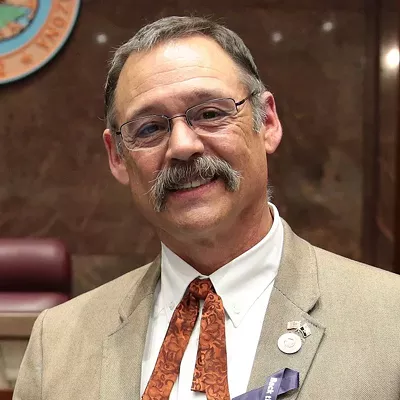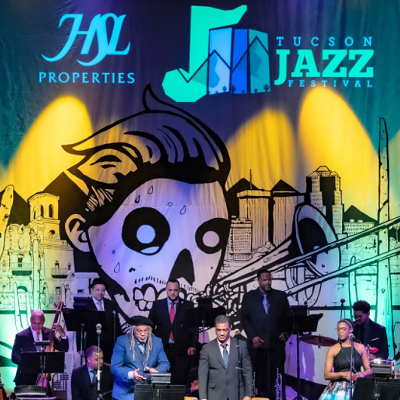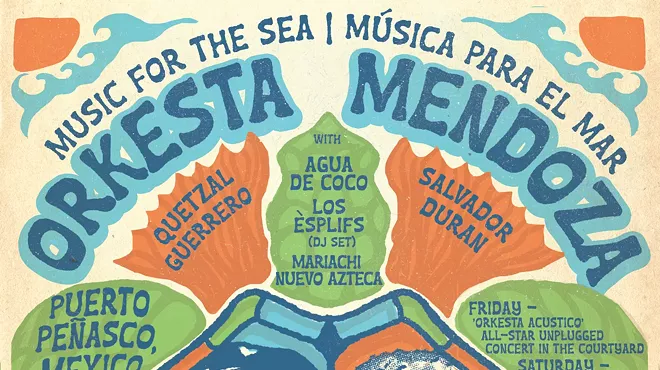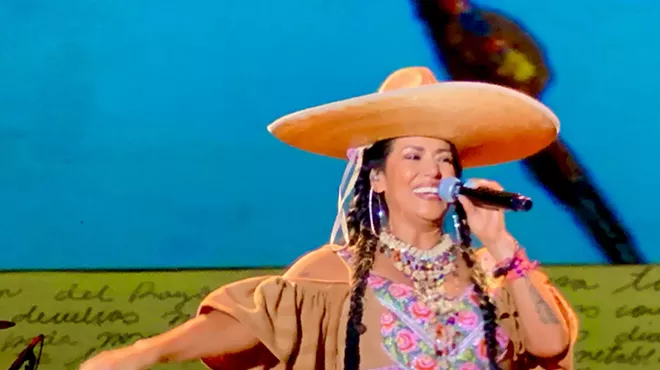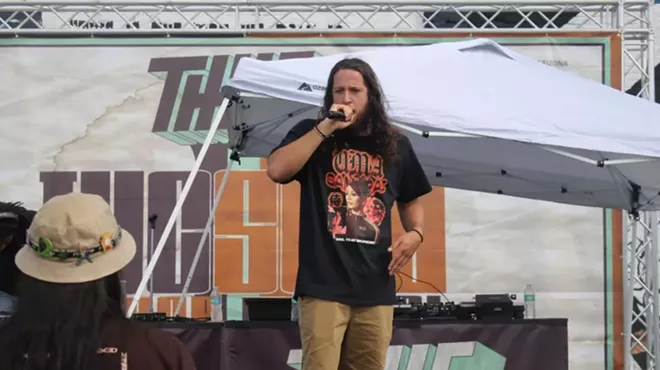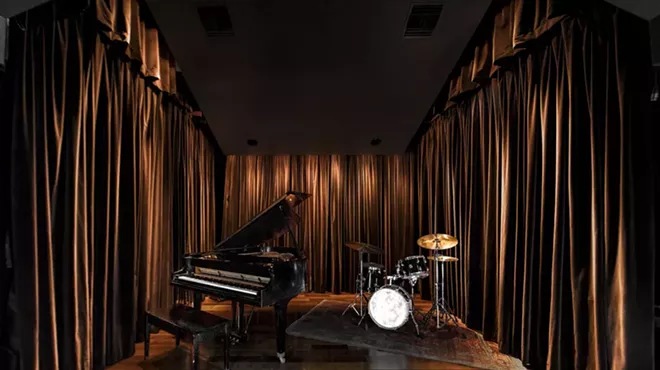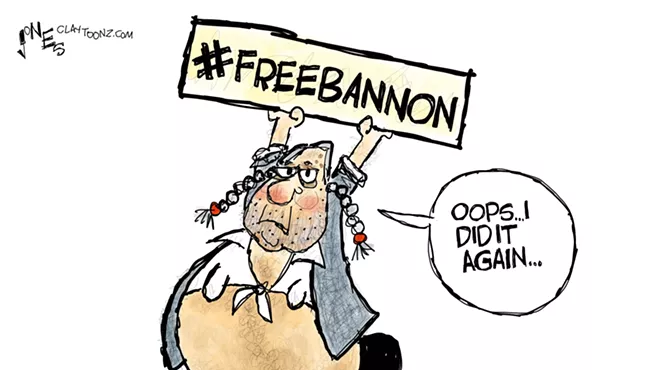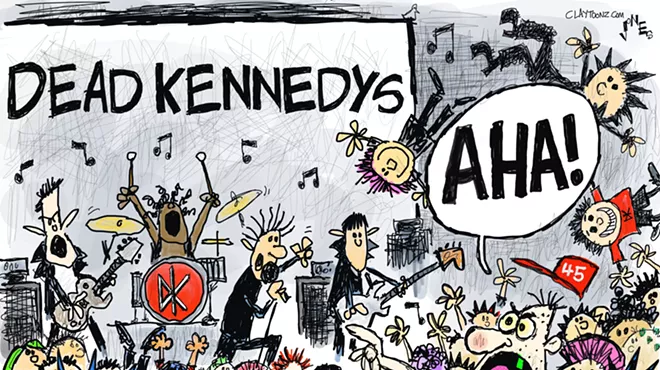Friday, February 12, 2016
New Marianne Dissard Compilation Revisits Tucson Albums
During her two decades in Tucson, the French-born chanteuse Marianne Dissard began a musical career that naturally brought her home country's traditions into the already mixed pot of the local scene.
Dissard's studio albums—L'Entredeux, L'Abandon and The Cat. Not Me—found her collaborating with a who's who of Tucson musicians, many of whom she'd take on tours in Europe, expanding Tucson's reputation as a musical oasis. Three other releases form the City Series collected different arrangements in live takes recorded during impromptu sessions while on tour in Paris, Berlin and Cologne.
Today, Dissard is releasing Cibola Gold, a 13-song best-of collection that pulls from five of those albums, presenting an overview of her Tucson years and musical output. Dissard moved to Europe in 2013 and talked via e-mail about putting the new project together and how that found her looking back over her years spent in Tucson:
What sort of thoughts and reflections about your musical experiences in Tucson did this collection spark?
I didn't anticipate that I'd be so moved by the process of putting together this collection of, not only music, but images and words. To design the 24-page booklet, I sifted through hundreds of photos. I saw faces of people who had been dear throughout the years, some dead already.
I left Tucson in 2013 and had been glad at first to not look back, diving into countless projects here in Europe to numb the shock of being uprooted again. But truly, what surfaced after the thrill of remembering and the pangs of regrets waned is the generosity of the Tucson music scene, its work ethic and a sense of community so strong that I feel like the kid now off to college who still struggles to justify skipping his first Thanksgiving family reunion.
How did collaborating with so many members of Tucson’s musical community influence your music and art?
Tucson has always been more than music for me. It's also film, performance and literature. The first time I ever came to town was in 1989 to interview filmmaker Alex Cox. His were the Americas I wanted to inhabit, a grand-standing and bravura maelstrom of punk cowboys and activist rock-stars. Then later that year, I met Howe Gelb and John Convertino for the first time. Not 20 yet, I became Howe's roommate in Hollywood for a short bit. Giant Sand's music was my wallpaper for many years, my schooling too. In 1994, I made a documentary film called Drunken Bees on Howe and his bandmates. That film was truly my entry point into Tucson.
It took 10 years - and the encouragement of another local luminary, Joey Burns - before I could even think of getting on stage myself. Naïm Amor, my husband at the time, and Arthur Vint were my first backing band. I played with a lot of Tucson musicians. My music is their music. I owe them everything.
I loved the University of Arizona Poetry Center and Spork Press. Poet Richard Siken had always felt like the brother-in-arms I admired from afar. As for performance arts, I owe a lot to the crews that breathed life into the Downtown Performance Center, Luna Café, the brave programmers of Club Congress, Red Room and Surly Wench. Tucson was the laboratory where I explored what I had been exposed to working in Europe with avant-contemporary choreographers.
Is there a particular sound or vibe you think of when you think of Tucson?
The trumpet sound of Jon Villa. Salvador Duran on stage with Orkesta Mendoza. Isaiah Toothtaker's drawl. Howe Gelb's somber guitar screeches. Bob Log III's heartbeat-paced, trance-inducing blues. The Sunday brunch trio of Matt Mitchell's Hot Club. Chicken scratch medleys on a cassette tape. Pork Tortas' sense of style. Cranky DM jets petering over downtown. The accordion sound in a Norteño tune. Cicadas. KTUC's oldies streaming from my Cadillac's radio. The whirl of an 8-track cassette of Johnny Cash at home. Porch lullabies and firepits melodies late summer nights. KXCI fading out by Ajo. The blind piano player at Crossroads Restaurant on Sundays. The beating hearts of a Downtown Saturday Night crowd and performers. Rainer Ptacek in the lobby of Hotel Congress. Mariachi Luz De Luna after a few drinks. The no-night off-kilter warbles at Red Room.
You’ve gotten to help introduce many Tucson musicians to European audiences. Why do you think Tucson musicians have a history of being embraced by European audiences?
I always strived to pay my debts to the arts and music scene that made me who I am and enabled me to leave it confident in my own doings. It's been up to the musicians to take advantage of the exposure I helped sustain. Connor Gallaher's first trip abroad was at age 17 on a tour organized for us by Le Pop, the German label that released first my record and then, after having met one by one the musicians who accompanied me, those of Naïm, Brian, Andrew Collberg, Orkesta Mendoza. For SXSW 2013, I produced a Festival-sanctioned Tucson showcase. And I keep spreading the gospel of Tucson music in Europe. Here in Paris, I'm regularly asked to produce albums of French chanson with that special little Tucson 'something'. What's not to like? We're so very exotic and yet so very relatable, I suppose. Also so very hungry.
Why the title Cibola Gold?
Cibola, the seven cities of gold of the Aztec, believed by the conquistadores to be located somewhere in the Sonora desert. Cibola Gold? The elusive, virtual treasure I brought back from my own quest of three decades in the American West.
I chose a picture of Garry Winogrand for the album cover. Two children playing in a sand dune, oblivious to the world, serious in their games and the illusions they necessarily create. There's a vibrancy, a joy and great humor in that photo. Nostalgia also, fragility, ephemera and a dread too, contradictions that I have always tried to embody in my music.
Stream or purchase Cibola Gold at Dissard's Bandcamp page.
Dissard's studio albums—L'Entredeux, L'Abandon and The Cat. Not Me—found her collaborating with a who's who of Tucson musicians, many of whom she'd take on tours in Europe, expanding Tucson's reputation as a musical oasis. Three other releases form the City Series collected different arrangements in live takes recorded during impromptu sessions while on tour in Paris, Berlin and Cologne.
Today, Dissard is releasing Cibola Gold, a 13-song best-of collection that pulls from five of those albums, presenting an overview of her Tucson years and musical output. Dissard moved to Europe in 2013 and talked via e-mail about putting the new project together and how that found her looking back over her years spent in Tucson:
What sort of thoughts and reflections about your musical experiences in Tucson did this collection spark?
I didn't anticipate that I'd be so moved by the process of putting together this collection of, not only music, but images and words. To design the 24-page booklet, I sifted through hundreds of photos. I saw faces of people who had been dear throughout the years, some dead already.
I left Tucson in 2013 and had been glad at first to not look back, diving into countless projects here in Europe to numb the shock of being uprooted again. But truly, what surfaced after the thrill of remembering and the pangs of regrets waned is the generosity of the Tucson music scene, its work ethic and a sense of community so strong that I feel like the kid now off to college who still struggles to justify skipping his first Thanksgiving family reunion.
How did collaborating with so many members of Tucson’s musical community influence your music and art?
Tucson has always been more than music for me. It's also film, performance and literature. The first time I ever came to town was in 1989 to interview filmmaker Alex Cox. His were the Americas I wanted to inhabit, a grand-standing and bravura maelstrom of punk cowboys and activist rock-stars. Then later that year, I met Howe Gelb and John Convertino for the first time. Not 20 yet, I became Howe's roommate in Hollywood for a short bit. Giant Sand's music was my wallpaper for many years, my schooling too. In 1994, I made a documentary film called Drunken Bees on Howe and his bandmates. That film was truly my entry point into Tucson.
It took 10 years - and the encouragement of another local luminary, Joey Burns - before I could even think of getting on stage myself. Naïm Amor, my husband at the time, and Arthur Vint were my first backing band. I played with a lot of Tucson musicians. My music is their music. I owe them everything.
I loved the University of Arizona Poetry Center and Spork Press. Poet Richard Siken had always felt like the brother-in-arms I admired from afar. As for performance arts, I owe a lot to the crews that breathed life into the Downtown Performance Center, Luna Café, the brave programmers of Club Congress, Red Room and Surly Wench. Tucson was the laboratory where I explored what I had been exposed to working in Europe with avant-contemporary choreographers.
Is there a particular sound or vibe you think of when you think of Tucson?
The trumpet sound of Jon Villa. Salvador Duran on stage with Orkesta Mendoza. Isaiah Toothtaker's drawl. Howe Gelb's somber guitar screeches. Bob Log III's heartbeat-paced, trance-inducing blues. The Sunday brunch trio of Matt Mitchell's Hot Club. Chicken scratch medleys on a cassette tape. Pork Tortas' sense of style. Cranky DM jets petering over downtown. The accordion sound in a Norteño tune. Cicadas. KTUC's oldies streaming from my Cadillac's radio. The whirl of an 8-track cassette of Johnny Cash at home. Porch lullabies and firepits melodies late summer nights. KXCI fading out by Ajo. The blind piano player at Crossroads Restaurant on Sundays. The beating hearts of a Downtown Saturday Night crowd and performers. Rainer Ptacek in the lobby of Hotel Congress. Mariachi Luz De Luna after a few drinks. The no-night off-kilter warbles at Red Room.
You’ve gotten to help introduce many Tucson musicians to European audiences. Why do you think Tucson musicians have a history of being embraced by European audiences?
I always strived to pay my debts to the arts and music scene that made me who I am and enabled me to leave it confident in my own doings. It's been up to the musicians to take advantage of the exposure I helped sustain. Connor Gallaher's first trip abroad was at age 17 on a tour organized for us by Le Pop, the German label that released first my record and then, after having met one by one the musicians who accompanied me, those of Naïm, Brian, Andrew Collberg, Orkesta Mendoza. For SXSW 2013, I produced a Festival-sanctioned Tucson showcase. And I keep spreading the gospel of Tucson music in Europe. Here in Paris, I'm regularly asked to produce albums of French chanson with that special little Tucson 'something'. What's not to like? We're so very exotic and yet so very relatable, I suppose. Also so very hungry.
Why the title Cibola Gold?
Cibola, the seven cities of gold of the Aztec, believed by the conquistadores to be located somewhere in the Sonora desert. Cibola Gold? The elusive, virtual treasure I brought back from my own quest of three decades in the American West.
I chose a picture of Garry Winogrand for the album cover. Two children playing in a sand dune, oblivious to the world, serious in their games and the illusions they necessarily create. There's a vibrancy, a joy and great humor in that photo. Nostalgia also, fragility, ephemera and a dread too, contradictions that I have always tried to embody in my music.
Stream or purchase Cibola Gold at Dissard's Bandcamp page.
Tags: marianne dissard , tucson , music , french , cibola gold , new , album , release , Video


